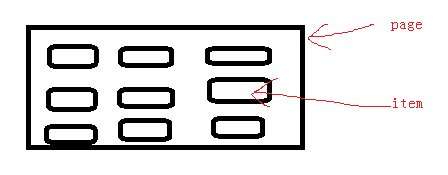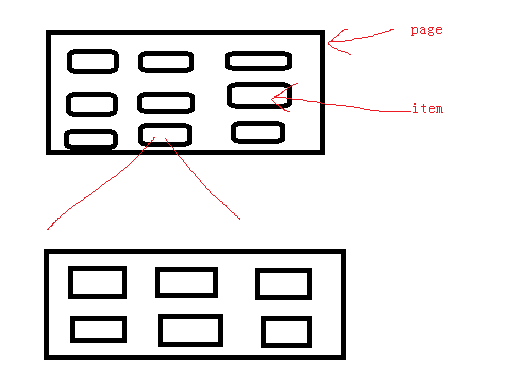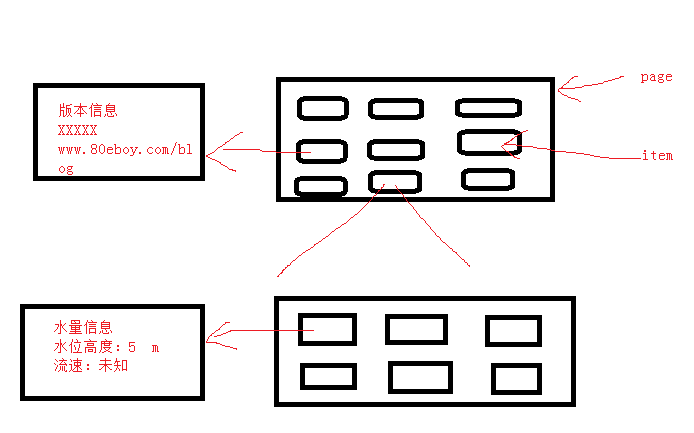相信很多攻城獅都用過液晶屏,想寫好一點(diǎn)的ui好像不太可能或且花費(fèi)很多時(shí)間,直接寫吧,感覺好像很零碎,coding都怕了。
下面介紹一個(gè)簡單易用的菜單框架,你會發(fā)現(xiàn)它能做多層菜單而且結(jié)果清晰。
基本原理:  ????
????
如上圖液晶顯示一屏我們定義為一個(gè)page,page中的項(xiàng)目定義為item;這樣page就是item的容器了。當(dāng)我們選中其中的一個(gè)item進(jìn)去后是不是又是一個(gè)page呢,如下圖。  ????
????
這樣的話每一個(gè)item的下面都對應(yīng)一個(gè)page,這樣是不是就構(gòu)成一個(gè)多層的菜單了。 ? ????
? ????
他們是什么關(guān)系呢?
一個(gè)page中有item,那么用結(jié)構(gòu)體就可以實(shí)現(xiàn)啦;item下面又有page,那么在item中加一個(gè)page的指針指向item對應(yīng)的page頁。
前面都是從上到下的,那么怎么返回呢?
觀察發(fā)現(xiàn)返回就是子page返回父page,這樣在page結(jié)構(gòu)體中假如一項(xiàng)父page的指針不就ok了。
具體實(shí)現(xiàn)請看源文件。
/******************************************************************************************************/
//主菜單
//定義Item項(xiàng) //顯示方式&序號 項(xiàng)目的名字 項(xiàng)目指向的頁(Page)
const struct Item main_item[]={ 0x00, "信息", &SMS_Page,
0x01, "設(shè)置", &Setting_Page,
0x02, "版本", &Version_Page,
0x03, "時(shí)間", &Time_Page,
0x04, "狀態(tài)", 0,
0x05, "報(bào)警", 0,
0x06, "飛信", 0,
0x07, "問答", 0
};
//定義一個(gè)Page 父頁 該頁的回調(diào)函數(shù) 該頁的項(xiàng) 項(xiàng)的個(gè)數(shù)
const struct PAGE mainPage={0,mainPageCallBack,main_item,sizeof(main_item)/sizeof(struct Item)};
/*********************************************************************************************************/
const struct PAGE Version_Page={&mainPage,Version_CallBack,0,0};
/***************************************************************************************************************/
//定義Item項(xiàng) //顯示方式&序號 項(xiàng)目的名字 項(xiàng)目指向的頁(Page)
const struct Item Setting_item[]={ 0x10, " 00.設(shè)0", 0,
0x11, " 01.設(shè)1", 0,
0x12, " 02.設(shè)2", 0,
0x13, " 03.設(shè)3", 0,
0x14, " 04.設(shè)4", 0,
0x15, " 05.設(shè)5", 0,
0x16, " 06.設(shè)6 你好", 0,
0x17, " 07.設(shè)7", 0,
0x18, " 08.設(shè)8", 0,
0x19, " 09.設(shè)9", 0,
0x1A, " 10.設(shè)10", 0
};
const struct PAGE Setting_Page={&mainPage,Setting_CallBack,Setting_item,sizeof(Setting_item)/sizeof(struct Item)};
/***************************************************************************************************************/
const struct PAGE Time_Page={&mainPage,Time_CallBack,0,0};
/***************************************************************************************************************/
//定義Item項(xiàng) //顯示方式&序號 項(xiàng)目的名字 項(xiàng)目指向的頁(Page)
const struct Item SMS_item[]={
0x10, " 00.", &SMS_Text_Page,
0x11, " 01.", &SMS_Text_Page,
0x12, " 02.", &SMS_Text_Page,
0x13, " 03.", &SMS_Text_Page,
0x14, " 04.", &SMS_Text_Page,
0x15, " 05.", &SMS_Text_Page,
0x16, " 06.", &SMS_Text_Page,
0x17, " 07.", &SMS_Text_Page,
0x18, " 08.", &SMS_Text_Page,
0x19, " 09.", &SMS_Text_Page,
0x1A, " 10.", &SMS_Text_Page
};
const struct PAGE SMS_Page={&mainPage,SMS_CallBack,SMS_item,sizeof(Setting_item)/sizeof(struct Item)};
Menu.h:
#ifndef _Menu_H_BAB #define _Menu_H_BAB #include "stm32f10x.h" #include "LCD.h" #include "Key.h" #define KEY_Special 255 ///<這個(gè)保留用于特別事件 //菜單調(diào)試,在調(diào)試時(shí)最好定義,可以幫助發(fā)現(xiàn)問題;當(dāng)發(fā)布時(shí)把其置為0可以加快速度 #define MENU_DEBUG 1 void Menu_Show(void); struct PAGE { const struct PAGE *pParent; void (*Function)(u8 key); const struct Item *pItem; const u8 ItemNum; }; struct Item { /** 高4位作為特殊用途(bit4=1表示列表顯示否則兩列顯示),低4位用于標(biāo)記Item的序號 如果為列表模式時(shí)*pText的格式為:" xx.string",最前面保留一個(gè)空格用于個(gè)光標(biāo)(>)使用,xx.為兩位序號不要"."一定要有,string是要顯示的文字,最多能顯示6個(gè)漢字 如果是兩列顯示則pText,即為要顯示的文本(最多2個(gè)漢字) */ const u8 TypeAndIndex; const u8 *pText; const struct PAGE *pChildrenPage; }; extern const struct PAGE *pPage; void SetMainPage(const struct PAGE *pMainPage); void ShowMenu(const struct PAGE *pPage); void ShowPage(const struct PAGE *pPage); void ShowParentPage(void); void ShowItemPage(void); void SelPageItem(u8 ItemIndex); u8 Menu_GetSelItem(void); void GetShowLst(u8 *pOutMin,u8 *pOutMax); void KeySelItem(u8 key); #endif
Menu.c:
#include "Menu.h" //保存選中的菜單項(xiàng)變量 static u8 SelItem=0; /** 用于當(dāng)前LCD列表中顯示著哪幾項(xiàng) 高4位:最大序號 低4為:最小序號 */ static u8 ListShow=0x00; const struct PAGE *pPage; void SelItemOfList(u8 index); void SetMainPage(const struct PAGE *pMainPage) { pPage=pMainPage; } /** 獲得當(dāng)前選中的菜單項(xiàng) @return 返回菜單序號 */ u8 Menu_GetSelItem(void) { return SelItem; } /** 獲取當(dāng)前顯示列表的范圍 @param pOutMin 當(dāng)前顯示的最小序號 @param pOutMax 當(dāng)前顯示的最大序號 */ void GetShowLst(u8 *pOutMin,u8 *pOutMax) { *pOutMin=ListShow&0x0f; *pOutMax=ListShow>>4; } void ShowList(u8 min,u8 max) { u8 i=0,index=0; #if MENU_DEBUG if(max-min>3) { Lcd_Clr_Scr(); LCD_Write_Str(0,0,"err:ShowList>3"); while (1); } if ((pPage->pItem[0].TypeAndIndex & 0x10)==0)///<如果是使用列表方式 { Lcd_Clr_Scr(); LCD_Write_Str(0,0,"不是列表類型不能不能列出"); while (1); } #endif Lcd_Clr_Scr(); for (index=min;index<=max;index++) { LCD_Write_Str(i++,0,pPage->pItem[index].pText); } ListShow=(max<<4)|min; ///<記錄當(dāng)前顯示的Item } /** 頁顯示 1.當(dāng)這個(gè)頁有項(xiàng)目(Item)時(shí):顯示Item并同時(shí)選中Item 0 2.沒有時(shí):會調(diào)用該P(yáng)age的回調(diào)函數(shù)并傳入KEY_Special 參數(shù) @param pPage 指向一個(gè)page */ void ShowPage( const struct PAGE *pPage) { s8 i; ///清屏 Lcd_Clr_Scr(); if(pPage->pItem==0) { pPage->Function(KEY_Special); return; ///<如果沒有Item項(xiàng)則不顯示Item,直接返回 } if (pPage->pItem[0].TypeAndIndex & 0x10)///<如果是使用列表方式 { ShowList(0,3); SelItemOfList(0); pPage->Function(KEY_Special); } else { ///取出page中的Item并顯示 for (i=0;iItemNum;i++) { if (i<4) { LCD_Write_Str(i,1,pPage->pItem[i].pText); } else { LCD_Write_Str(i-4,5,pPage->pItem[i].pText); } } SelPageItem(0);///<選中Item 0 pPage->Function(KEY_Special); } }; /** 顯示父頁(ParentPage) */ void ShowParentPage(void) { pPage=pPage->pParent; ShowPage(pPage); } /** 顯示項(xiàng)目(Item)下對應(yīng)的頁(Page) */ void ShowItemPage(void) { //如果該項(xiàng)下沒有頁,這警告或返回 if (pPage->pItem[Menu_GetSelItem()].pChildrenPage ==0) { #if MENU_DEBUG Lcd_Clr_Scr(); LCD_Write_Str(0,0,"該項(xiàng)下無顯示請修正"); while (1); #else return; #endif } pPage=pPage->pItem[Menu_GetSelItem()].pChildrenPage; //獲得菜單項(xiàng)(Item)對應(yīng)的page ShowPage(pPage); } /** 選擇page中的Item項(xiàng) @param ItemIndex page中Item的索引號 0~7 */ void SelPageItem(u8 ItemIndex) { ///檢查是否有錯誤調(diào)用 #if MENU_DEBUG if (ItemIndex>=8) { LCD_Write_Str(0,0,"設(shè)置菜單項(xiàng)溢出"); return; } #endif ///清除上次選中的 if (SelItem<4) { LCD_Write_Str(SelItem,0," "); LCD_Write_Str(SelItem,3," "); } else { LCD_Write_Str(SelItem-4,4," "); LCD_Write_Str(SelItem-4,7," "); } ///選中這次要選中的 if (ItemIndex<4) { LCD_Write_Str(ItemIndex,0,"【"); LCD_Write_Str(ItemIndex,3,"】"); SelItem=ItemIndex; } else { LCD_Write_Str(ItemIndex-4,4,"【"); LCD_Write_Str(ItemIndex-4,7,"】"); SelItem=ItemIndex; } }; void SelItemOfList(u8 index) { u8 max; u8 min; max=ListShow>>4; min=ListShow&0x0f; if (index>max) ///<超出最大當(dāng)前顯示的序號 { LCD_Write_Str(Menu_GetSelItem()-min,0," "); min+=1; max+=1; ShowList(min,max); ListShow=(max<<4)|min; LCD_Write_Str(index-min,0,">"); } else if(index>=min)///<在最小和最大序號之間 { LCD_Write_Str(Menu_GetSelItem()-min,0," "); LCD_Write_Str(index-min,0,">"); } else ///<低于最小當(dāng)前顯示最小序號 { LCD_Write_Str(Menu_GetSelItem()-min,0," "); min-=1; max-=1; ShowList(min,max); ListShow=(max<<4)|min; LCD_Write_Str(index-min,0,">"); } SelItem=index; } void KeySelItem(u8 key) { s8 index; if (pPage->pItem[0].TypeAndIndex & 0x10)///<如果是使用列表方式 { switch(key) { case KEY_UP: index=Menu_GetSelItem()-1; if(index<0) break; SelItemOfList(index); break; case KEY_Down: index=Menu_GetSelItem()+1; if(index>(pPage->ItemNum-1)) break;; SelItemOfList(index); break; } return; } switch(key) { case KEY_UP: index=Menu_GetSelItem()-1; if(index<0) index=pPage->ItemNum-1; SelPageItem(index); break; case KEY_Down: index=Menu_GetSelItem()+1; if(index>(pPage->ItemNum-1)) index=0; SelPageItem(index); break; case KEY_Left: case KEY_Right: index=Menu_GetSelItem(); if (index<4) { if((index+4)>(pPage->ItemNum-1)) return; //右沒有Item項(xiàng),無法選中右邊項(xiàng);所以返回 index+=4; //右邊有Item時(shí)把index定位到右邊的Item } else index-=4; //因?yàn)橛疫呌蠭tem項(xiàng)時(shí),左邊一定有Item項(xiàng);因?yàn)槭前错樞虬才诺? SelPageItem(index); break; } }
篇幅有限,MenuAPP代碼未貼出。
審核編輯:湯梓紅
-
液晶
+關(guān)注
關(guān)注
6文章
606瀏覽量
69692 -
STM32
+關(guān)注
關(guān)注
2270文章
10921瀏覽量
356998 -
液晶屏
+關(guān)注
關(guān)注
18文章
720瀏覽量
42947 -
指針
+關(guān)注
關(guān)注
1文章
481瀏覽量
70593
原文標(biāo)題:一個(gè)STM32菜單框架,文末附工程文件
文章出處:【微信號:c-stm32,微信公眾號:STM32嵌入式開發(fā)】歡迎添加關(guān)注!文章轉(zhuǎn)載請注明出處。
發(fā)布評論請先 登錄
相關(guān)推薦
12864液晶使用教程分享 基于MCU菜單框架設(shè)計(jì)方案

STM32簡易多級菜單(數(shù)組查表法)顯示方法

輕量級多級菜單控制框架
如何設(shè)計(jì)一個(gè)產(chǎn)品級MCU菜單框架
如何搭建基于STM32驅(qū)動OLED屏顯示三級菜單界面框架?
STM32系統(tǒng)時(shí)鐘框架圖
單片機(jī)實(shí)例:一個(gè)用單色屏做的菜單框架資料下載

一個(gè)產(chǎn)品級MCU菜單框架設(shè)計(jì)~

基于STM32F407的簡易菜單設(shè)計(jì)+LCD+按鍵

第一個(gè)STM32CubeIDE項(xiàng)目

一個(gè)帶LCD的簡單Arduino菜單

基于LCD驅(qū)動架構(gòu)的MCU菜單框架設(shè)計(jì)





 分享一個(gè)STM32菜單框架
分享一個(gè)STM32菜單框架












評論